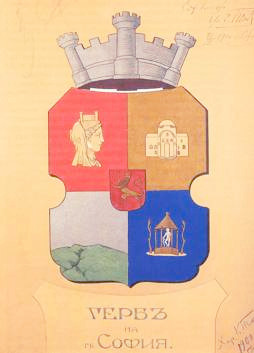
“Sofia obtained a coat of arms on the occasion of the World’s Fair held in Paris in the summer of 1900 in which Bulgaria took part. The Executive Committee of the fair requested also from our capital to submit a copy of its coat-of-arms to be put in the ceremonial hall. At that time, Mayor of the city was Mr. Hr. Popov. He quickly called Mr. Mrkvička, director of the School of Arts, Mr. Dobruski, director of the National Museum, and me. We collected material related to the city’s history and I was commissioned to make the coat of arms. I established the shape of the shield, divided it into four parts ('ecartel 'е —geviert), keeping the top two (the chief place) for the subject matter that gave the name of the city, and the bottom two - for other subjects, characteristic of the city. At the top right part (heraldry reverses right and left as it is from the point of view of someone holding the shield from behind) I placed the image of ULPIA SERDICA taken from an antique coin to highlight the old name of Sofia – Serdica; at the top left part I placed the Church of St. Sophia, which gave the present name of the city; at the lower left part – Vitosha - the centuries-old witness of historical events; at the lower left - a golden baldachin and a statue of Apollo Medicus representing the mineral springs in and around Sofia. This image is also taken from an antique coin. At the time, when I worked on the coat of arms, Dobrusky showed me a medallion unearthed at the excavations of Trapezitsa - Veliko Tarnovo. A lion in a leaping position and a little lion beneath it were depicted on red enamel. I took the big lion and placed in on another smaller shield, which I put in the middle of the main shield - in the heart (dans I'abime), according to the heraldic expression. This theme also serves to emphasize that Sofia is the successor of the old capital Veliko Tarnovo. On the top of the shield I put a crown of walls and towers — couronne murale — Wandkrone, an element typically reserved only for city coat of arms. Prince Ferdinand, a great connoisseur of heraldic art, liked it very much, approved it and a copy was made and sent to Paris; "- Haralampi Tachev, About the Coat of Arms of Sofia.,”Razvigor ", no. 8/21. III. 1937.

1900 — First coat of arms of Sofia after the Liberation
1911 — Haralampi Tachev added the motto: “Sofia is growing but it is not getting old”
1928 — Haralampi Tachev gave it a final touch by adding a band with the motto and laurel twigs
1974 — Ivan Radev added a five-pointed star and additionally stylized the coat of arms
1991 — the coat of arms is restored to its original version by Haralampi Tachev of 1928.
By Decision No. 743 of 19.12.2013, Sofia City Council approved five images of the Sofia coat of arms.
An echo of Serdica's past in the Sofia Coat of Arms
The left upper side of the divided into five parts shield of the Sofia coat of arms is occupied by a female image with hair put up in a knot. The hair is covered with a richly pleated veil whose edges surround the face in slight creases and descend freely to the shoulders. On the head in front of the knot, in the form of a crown, there are city walls, flanked by towers with pinnacles. This image recreates the main iconographic features of a familiar type represented on coins of the most significant urban centres in Thrace during the Roman era - Serdica (Sofia), Pautalia (Kyustendil), Philippopolis (Plovdiv), Augusta Traiana (Stara Zagora) and Hadrianopolis (Edirne)..
Around this type, which is defined as an image of city goddess because of the presence of a wall crown, there is a circular inscription in Greek bearing the name of the relevant city government. The face of the bronze coins is occupied by the same portrait image of the despotic Roman Empress Julia Domna, wife to Septimius Severus and mother of Emperors Geta and Caracalla.

The comparison of these observations indicates that in some of the most significant centres in Thrace, against the background of specific political events, the cult of the almighty Julia Domna merged with that of the respective city goddesses. The use of one and the same unusual coin type, glorifying in a particularly artistic way the vainglorious Julia Domna as the patron of the cities, is apparently connected with events of a political nature that affected equally the mentioned urban centres in Thrace.
The listing of their names sheds light on an interesting, unifying factor related to their geographical location. Three of them - Serdica, Philippopolis and Hadrianopolis are the main stations on one of the most important strategic roads connecting the capital with the eastern Roman provinces. This road crossed Thrace from the northwest to the southeast. The other two cities, Pautalia and Augusta Traiana, without being stations along the mentioned route, possessed adjacent territories. The names of these five cities for the time being are the only ones evidenced on the road pillars of Thrace. From the inscriptions it has long been established that the pillars were in fact honorary monuments erected to honour the passage of the respective emperor and his suite through Thrace. The journey of the emperor from the capital to the remote Roman provinces or back, given the road and transport conditions of that time, continued for several months and was an event of great importance for the districts and the cities he passed through.
The Roman historian Dio Cassius (155-235), who lived during the Severus dynasty, gave a number of interesting and curious facts of the organization of these trips, carefully prepared by the imperial administration. All provincial governors were informed in advance about the route the emperor in order to take the necessary measures for the roads’ recovery and repair. Cities designated as places for the temporary rest of the ruler made enormous spending to respond with dignity to the given honour. Their administrations organized games, erected statues, rammed road pillars. Medallions were mint to commemorate the event and special coins were issued in circulation.
In the light of all this, we can rightly assume that the occasion for the coinage of Julia Domna's image was a journey of the Empress through Thrace. In the historical information available, the name of Julia Domna as Septimius Severus' wife, and later as the mother of Emperor Caracalla, is related to two journeys of the emperor and his suite through the Roman provinces on the Balkan Peninsula. The first one took place in 202 when, after his long triumphant trip to Africa and Asia Minor, Septimius Severus, accompanied by his family, his wife and two children, arrived in Byzantium (Istanbul), one of the strongholds of his recent rival Pescennius Niger. From there, according to Roman authors, "he visited many other cities in Thrace". We can understand which these cities were from the contents of the road pillars erected in the honour of Septimius Severus. One of them was found on the territory of Serdica and another was in Augusta Traiana.
The comparison of the data by the ancient authors with those of the epigraphic monuments and with the analysis of the numismatic material shows that Hadrianopolis, Philippopolis and Serdica were among the cities of Thrace, visited by Septimius Severus and Julia Domna, although en route, as they were main stations on the strategic road known in the Roman itineraria (guides) under the name "71 Road". For the second time, in 214, already as the mother of the young Emperor Caracalla, Julia Domna travelled through the Roman provinces on the Balkan Peninsula on the way to Asia Minor. According to the sources, the imperial convoy followed the road along the Danube Limes to the Black Sea coast and from there, along the famous Pontian route descended to Byzantium. Thus, some of the largest urban centres in Thrace remained out of the course of the Emperor and his mother. Among them was Philippopolis, whose administration, in the words of Dio Cassius, spent in vain huge amounts of money for the Alexandrian games organized in the honour of Caracalla. Apparently, along with Philippopolis, in 214, the other two main stations on "71 Road", Serdica and Hadrianopolis, also remained away from the course of the Emperor and his convoy. The same applied also to the adjacent to the road territories of Pautalia and Augusta Traiana.
All this indicates that the representation of Julia Domna as a city goddess on the coins of Serdica, Pautalia, Philippopolis, Augusta Traiana and Hadrianopolis is related to the first journey of the Empress in Thrace in 202. At that time, Thrace was one of the last stages in the long and exhausting journey of Septimius Severus and Julia Domna. Therefore, it is possible that they stayed longer than planned in some of the Thracian cities. Among them was Serdica, whose picturesque location, rich vegetation and its famous healing mineral springs turned it into a captivating place for healing and relaxation.
The duration of the stay of Septimius Severus and Julia Domna in Serdica cannot be established with precision, but it has been reflected both in the pillars erected in honour of the Emperor and in the issuance of numerous coin mints. The governance of Serdica expressed in an original and artistic way their feelings of gratitude to the imperial family for their stay in the city, which was considered to be an expression of extraordinary esteem and honour. To these purely moral feelings was added the material satisfaction of a significant portion of the Serdica citizens who earned additional income from the stay of the huge imperial entourage.
In order to flatter the self-esteem of the Imperial couple, who during their journey to the eastern Roman provinces were worshiped everywhere as the most respected local deities, Serdica merged the imperial cult of Julia Domna with that of its city goddess. The same process is also traced back to the coins of Pautalia, Philippopolis, Augusta Traiana and Hadrianopolis.
Careful examination of the images of Julia Domna as a city goddess on the coins of the individual urban centres shows some new and interesting iconographic features in the representation of her distinctive mark - the wall crown. At a first glance, it has the same shape on all coins, i.e. consisting of city walls, flanked by towers crowned with pinnacles. However, on the coins of Pautalia and Serdica, the two side towers are with three pinnacles. The city wall that connects them is low, made of large, profiled stone blocks, whose outlines, despite the tiny size of the images, are clearly noticed. The low wall height at Pautalia is compensated by the sharp pinnacles ending at the upper ground - the so-called "warrior’s path".
On the coins of Philippopolis, the side towers are no longer with three, but with five pinnacles. The walls are tall and also end with pinnacles. The marked differences in the shape of the city walls and towers in the similar coinages of Pautalia, Serdica and Philippopolis suggest that everywhere the city walls in the crown of Julia Domna as a city goddess - patron of the respective city, do not represent a common type devoid of individuality, but different types of defence facilities. Their reproduction aimed at linking the anonymous city goddess, characterized by the portrait of Julia Domna, with the décor of the city known to the respective population. Thus, in an artistic way, one gained the notion of their goddess associated with the protection of the ‘home’ city walls and towers.
Like the Pautalia and Philippopolis coins, the coins of Serdica do not reproduce as an individual coin-type the images of the fortification facilities that provided the peaceful existence of the prosperous city. The look of the thick walls of Serdica made of large stone blocks flanked by solid round towers with pinnacles, is preserved only in the small crown on the head of a mysterious female image - that of Julia Domna as the city goddess of Serdica. The passed centuries have covered with oblivion the portrait features of a long-lived ruler. Her ageless, enchanting female image, crowned by the city walls of ancient Serdica is woven into the composition of the capital's coat of arms. The effigy of city walls, flanked by round towers with pinnacles, recreates the fortifications of ancient Serdica, which in their entirety reach us only through the wall crown of Julia Domna as the goddess patron of Serdica.
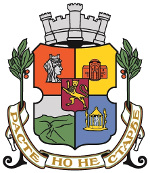
Colourful
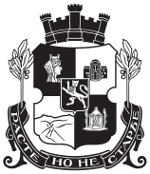
Black and white
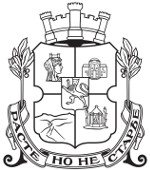
Contour
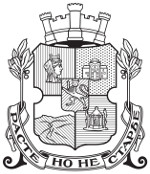
Heraldic code






